How Do Wick Hydroponics Work?
I get commissions for purchases made through links in this post. View our Affiliate Disclaimer.
Hydroponics is a method of plant growing without using soil. This technology has gained immense popularity in recent years owing to its various benefits, such as faster growth, increased yields, and efficient use of resources. One of the most straightforward hydroponic systems is wick hydroponics, which both hobbyists and commercial growers can use.
Wick hydroponics is a basic form of hydroponics using a wick made from natural or synthetic fibers to draw nutrient-laden water from a reservoir to the plant’s growing medium. The wick uses capillary action to draw the nutrients up from the reservoir and deliver them to the plant’s root system.
We will delve into the details of wick hydroponics, how it works, its benefits, and how to set up and maintain it. We will also discuss the crops that can be grown using this method and some troubleshooting tips. So, let’s get started and learn more about wick hydroponics!
What Are The Principles Of Wick Hydroponics?
Wick hydroponics is an excellent option for those who want to start their hydroponic journey without investing in expensive equipment.
In this system, plants are grown in a soilless medium and are provided with the required nutrients through a wick that connects the plant roots with a nutrient solution.
How Does Wick Hydroponics Work?
Wick hydroponics is a passive hydroponic system that utilizes a wick to transfer the nutrient solution from the reservoir to the plant roots.
The nutrient solution reservoir is usually positioned directly under the container holding the growing medium and the plant. The wick is positioned in the growing medium, extends through the container holding the plant, and dangles in the nutrient solution below.
The wick acts as a capillary, drawing the nutrient solution upward from the reservoir and into the growing medium. Once the growing medium is saturated with the nutrient solution, the plants can absorb the nutrients and water through their roots.
The wick acts as a conduit, constantly drawing the nutrient solution from the reservoir and into the growing medium. When the growing medium is saturated, the flow through the wick slows down or stops.
As the plants consume the nutrient solution, it causes the pressure differential, and the wick continues to draw more solution from the reservoir. The process ensures that the plants always have access to the necessary nutrients and water.
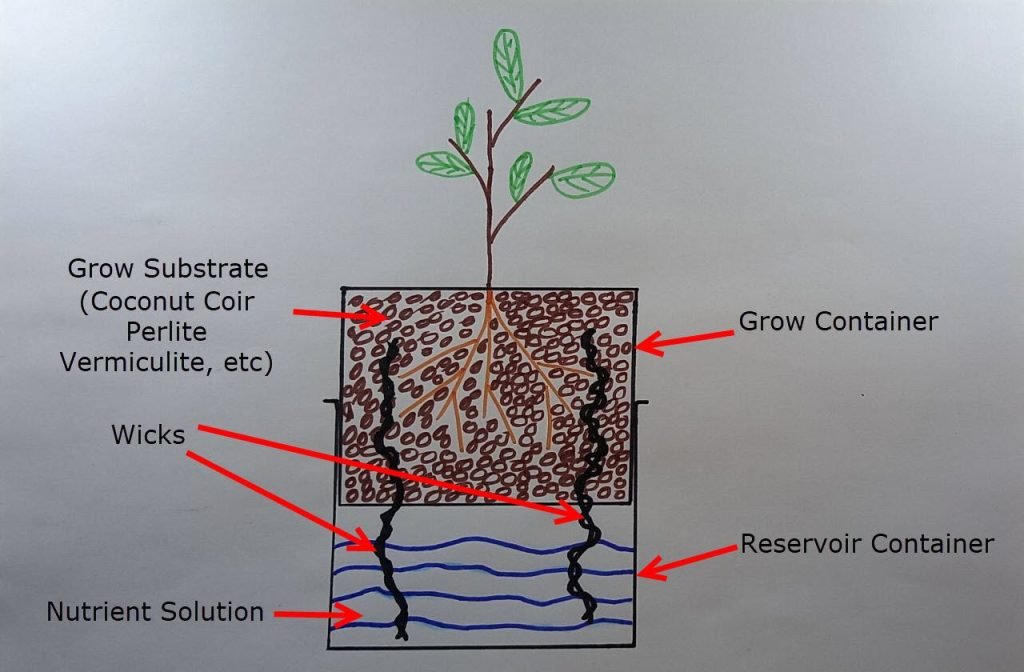
Components Required For Wick Hydroponics
Wick hydroponics uses basic equipment that is probably available in any household. The system’s simplicity allows anyone to set up a basic system and begin growing their own food.
The following are the components needed for a wick hydroponics system.
- Plant containers. Containers to hold the growing medium and the plant. The container should be able to nest inside the nutrient reservoir and be above the level of the nutrient solution.
- Reservoir. A container that holds the nutrient solution and is usually located below the plant containers.
- Growing medium. This is the material that replaces soil and provides support to the plant roots. Some common growing media include coconut coir, vermiculite, perlite, and rock wool.
- Wicks. The wick acts as a medium to transfer the nutrient solution from the reservoir container to the plant roots in the growing container. A nutrient wick can be made of various materials, such as cotton, nylon, or polyester.
- Nutrient solution. A balanced nutrient solution is required to give the plants the essential nutrients for their growth.
To set up a wick hydroponic system, start by filling the plant containers with the growing medium of your choice.
Next, insert the wick into the growing medium and ensure it is long enough to reach the nutrient solution in the reservoir below. Once this is done, fill the reservoir with the nutrient solution and place it below the plant container.
Best Growing Medium For Wick Hydroponics
The growing medium plays a crucial role in wick hydroponics, as it supports the plant roots and helps absorb the nutrient solution.
Choosing the right growing medium can affect the success or failure of the wick hydroponics system. The following growing mediums are the options I recommend as the best choices for this type of hydroponic growing.
- Coconut coir. A sustainable and eco-friendly option that is made from the fibrous husk of the coconut.
- Vermiculite. A natural mineral that is lightweight and has excellent water retention properties.
- Perlite. A lightweight volcanic glass commonly used as a soil amendment due to its ability to improve soil aeration and drainage.
- Rock wool. A synthetic material that is made from melted basalt rock and slag. It has excellent water retention properties and is widely used in hydroponic systems.
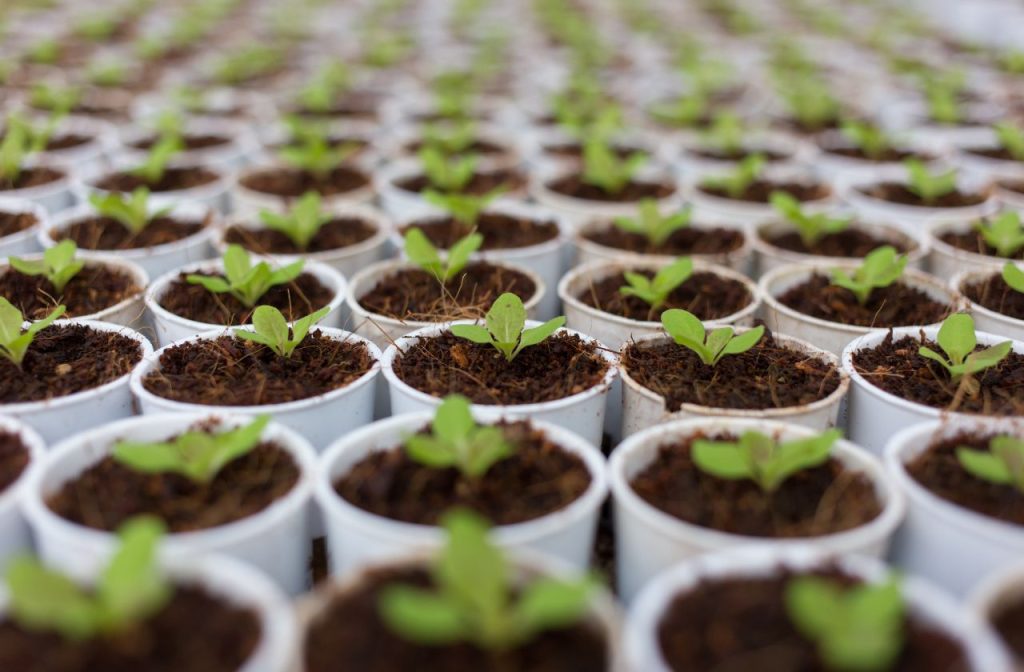
Best Wick Material For Wick Hydroponics
The choice of wick material can have a significant impact on the success of a wick hydroponic system.
The most common materials used for wicks in hydroponics are cotton, nylon, and polyester. Cotton wicks are popular because they are readily available, affordable, and absorbent. However, cotton wicks can break down quickly and become clogged with algae, reducing efficiency.
Nylon wicks are more durable than cotton and can withstand high temperatures and chemical exposure. However, nylon wicks are not as absorbent as cotton and may require more wicks to supply the right amount of nutrients.
Polyester wicks are also durable and can withstand high temperatures and chemical exposure, but they are less absorbent than cotton and nylon wicks.
Here are some other ideas for materials you can use as wicks in this type of hydroponics.
- Nylon rope
- Wool rope
- Kerosene lamp wicks
- Mop head strings
- Strips from old T-shirts or blankets

You can also purchase commercial self-watering wicks at relatively low prices, which is an alternative if you don’t have anything suitable on hand.
One of my favorite wicking materials is hemp twine, which is organic, unbleached, and uncolored, and the natural fibers provide great capillary action in the twine.
Another important aspect to consider when choosing a wicking material is its diameter. The diameter of the wick determines how much nutrient solution can be delivered to the roots of the plants.
A wick that is too thin may not be able to deliver enough nutrient solution, while a wick that is too thick may cause the hydroponic system to flood. A wick diameter of between 1/8 and 1/4 inch or 3 to 6 mm is recommended for most hydroponic systems.
Besides the material and diameter of the wick, the length of the wick is also important. The length of the wick should be long enough to reach the nutrient solution in the hydroponic container but not so long that it touches the bottom of the container. A good rule of thumb is to extend the wick about 1 inch or 2.5 cm into the nutrient solution.
Keeping the wick length as short as possible allows the nutrients-laden water to flow faster and easier from the reservoir to the plants. Thus, keeping the plant container directly above the reservoir in a wick system is best.
Benefits Of Wick Hydroponics
Wick hydroponics has several benefits, making it a popular choice for growers, particularly those just starting with hydroponic gardening and people who want to grow their own food.
The main benefits of wick hydroponics include the following.
- Low Cost. One of the most significant advantages of wick hydroponics is its low cost. Since the system is passive, it does not require any electricity or water pumps, making it an affordable option for growers on a tight budget.
- Easy to set up. Wick hydroponics is relatively simple to set up, even for beginners. With a few basic materials and equipment, growers can have a functioning hydroponic system up and running in no time.
- Low maintenance. Wick hydroponics requires minimal maintenance, as the nutrient solution is delivered passively through the wick. This makes this hydroponics method an ideal option for those who do not have the time or resources to maintain a more complex hydroponic system.
- Conserves water. Since wick hydroponics uses a passive delivery system, it is an excellent way to conserve water. The nutrient-laden water is delivered directly to the plant roots, reducing water waste through evaporation and runoff.
- Controlled environment. In a hydroponic system, growers have greater control over the growing environment, including temperature, humidity, and nutrient levels. This can result in healthier and more robust plants and higher yields.
- Space-saving. Wick hydroponics is a space-saving option for growers who do not have access to outdoor garden space or who want to maximize their indoor growing area. The system can be set up in a small area, such as a balcony, patio, or even a closet.
- Versatile. Wick hydroponics can be used to grow a wide variety of plants, including leafy greens, herbs, and vegetables. This makes it a versatile option for growers experimenting with different plant varieties.
Wick hydroponics offers several benefits, making it an attractive option for beginner and experienced hydroponic growers. Its low cost, ease of setup, and low maintenance requirements make it a great way to start growing plants hydroponically in a controlled and sustainable environment.
What Are The Disadvantages Of Wick Hydroponics?
Every hydroponics growing system has advantages and disadvantages, which is why there is not a one-size-fits-all hydroponics system for every situation.
Wick hydroponics has many advantages, but it also has some disadvantages that make it unsuitable as a system choice for some plants and situations.
- Limited nutrient delivery. Wick hydroponics relies on a passive system to deliver nutrients to the plants’ roots. While this method is effective for smaller plants, it may not be sufficient for larger or more demanding crops. As a result, growers may need to supplement their nutrient solution with additional fertilizers or upgrade to a more complex hydroponic system.
- Inconsistent water distribution. Water distribution may not be consistent, leading to uneven growth and nutrient uptake. This problem can be exacerbated if the wick becomes clogged or the reservoir’s water level is not monitored.
- Limited growing space. Because wick hydroponics relies on a passive system, the size of the plants that can be grown is limited. This growing system is best suited to small plants, such as herbs, leafy greens, and strawberries. Larger plants like tomatoes or peppers may require more advanced hydroponic systems.
While wick hydroponics is a straightforward and low-cost method of growing plants, it does have some limitations and drawbacks.
You should carefully consider the disadvantages and determine whether wick hydroponics is the best option for your needs. If the limitations are too restrictive, you may need to explore other types of hydroponic systems, such as DWC hydroponics, NFT hydroponics, drip hydroponics, or ebb and flow hydroponics, that offer greater flexibility and control.
Maintaining And Troubleshooting Wick Hydroponics
While wick hydroponics is a low-maintenance hydroponic system, there are still a few things growers should do to ensure their plants thrive.
The main maintenance tasks and troubleshooting aspects to expect with wick hydroponics systems are as follows.
- Check the nutrient solution. The nutrient solution is the lifeblood of any hydroponic system, including wick hydroponics. You must regularly check the nutrient solution’s pH and nutrient levels to ensure they are within the proper range for their plants. Additionally, the solution should be changed every two weeks to prevent toxic salt buildup.
- Monitor water levels. Since wick hydroponics is a passive system, the wick needs to stay wet to deliver the nutrient solution to the plant’s roots. Monitor the water level in the reservoir and refill it as needed to keep the wick moist.
- Clean the wick. Over time, the wick can become clogged with algae or other debris, impeding nutrient delivery to the plants’ roots. Regularly clean the wick to ensure it is functioning correctly.
- Check for pests and diseases. Just like traditional gardening, hydroponic systems can be vulnerable to pests and diseases. Growers should regularly check their plants for signs of pests and diseases and take appropriate action if necessary.
If you keep up with these maintenance tasks, troubleshooting the wick hydroponics system is relatively simple.
If plants are not growing as expected, growers should first check the nutrient solution’s pH and nutrient levels. The pH level is one of the most common problem areas in wick hydroponic systems.
If those are within the proper range, check the water level to ensure the wick is properly submerged in the nutrient solution. Also, check the wick to ensure it is in good condition and wet all the way to the growing substrate.
Light levels and temperature are also important factors. Ensure your plants get the right light and warmth levels to promote healthy plants.
While wick hydroponics is a low-maintenance hydroponic system, you should still perform regular maintenance and troubleshooting to ensure your plants thrive.
By monitoring the nutrient solution, water levels, wick, and plants, you can quickly identify and resolve any issues and grow healthy and robust plants.
Best Plants For Wick Hydroponics
Wick hydroponics is suitable for growing a wide variety of crops, including leafy greens, herbs, and vegetables. Some popular options include lettuce, spinach, basil, and tomatoes.
Wick hydroponics is a versatile and straightforward hydroponic system that can be used to grow a variety of crops.
When choosing a plant variety, it is essential to consider its nutrient requirements, growth habits, and suitability for wick hydroponic systems. Here are some of the most common crops that are suitable for wick hydroponics.
| Plants Suitable For Wick Hydroponics | ||
| Plant | Examples | Description |
| Leafy Greens | Lettuce Spinach Kale Arugula | They have a relatively short growth cycle and do not require a substantial root system. Additionally, they are easy to grow and can be harvested multiple times. |
| Herbs | Rosemary Basil Cilantro Parsley Mint | These herbs do not require a lot of space and can be grown year-round indoors. They have a high demand in the culinary industry and can be sold at a premium price. |
| Strawberries | All varieties | Strawberries are a popular crop for hydroponic systems, including wick hydroponics. They have shallow roots and do not require much space. They can be grown year-round, making them an excellent option for growers who want to maximize their yields. |
| Tomatoes | Bush tomatoes that don’t require staking work best | Tomatoes are a high-value crop that can be grown successfully in a wick hydroponic system. They require a bit more maintenance than leafy greens or herbs, but they can yield a substantial harvest if grown properly. |
| Peppers | Bell Peppers Chili Peppers | Peppers are well-suited to wick hydroponics. They grow fast and can be grown in small spaces. They are versatile crops with high market demand. |
Is Wick Hydroponics Effective To Grow Your Own Food?
Wick hydroponics is a type of hydroponic growing method that uses a wick to deliver water and nutrients to the plant roots. The wick system is simple and can be made with materials you probably have around the house.
Wick hydroponics is considered one of the most low-tech methods of hydroponic growing systems. This makes it one of the best hydroponics systems for homesteaders and rural situations where the electricity supply can be erratic.
This method is also one of the cheapest and easiest ways to get started in hydroponics. Wick systems are often used as a teaching tool in schools because they are so simple to set up and operate.
The biggest advantage of wick hydroponics is that it is very forgiving. If you forget to monitor your plants for a few days, they will not suffer as much as plants in other types of hydroponic systems.
Wick systems are also scalable, making them very easy to expand according to your requirements. If you want to add more plants to your system, you can simply add more wicks. There is no need to buy additional pumps or tubing.
The biggest disadvantage of wick hydroponics is that it is not as efficient as other types of hydroponic systems. Plants in a wick system will typically grow more slowly than plants in other types of hydroponic systems.
If you are looking for a hydroponic system that is easy to set up and operate and very forgiving, then a wick system may be the right choice.
Conclusion
Wick hydroponics is an excellent option for growers who want to start hydroponic gardening without investing in complex, expensive systems. It is a passive system that uses a wick to deliver the nutrient solution to plants’ roots, making it easy to set up and maintain. Wick hydroponics is an excellent option for both novice and experienced growers who want to start hydroponic gardening. With a little effort and maintenance, you can produce high-quality crops in a controlled and sustainable environment, leading to a more robust, reliable, and profitable harvest.
Get more posts like this
Subscribe to our mailing list and get interesting homesteading and green living info and updates to your email inbox.
Thank you for subscribing.
Something went wrong.




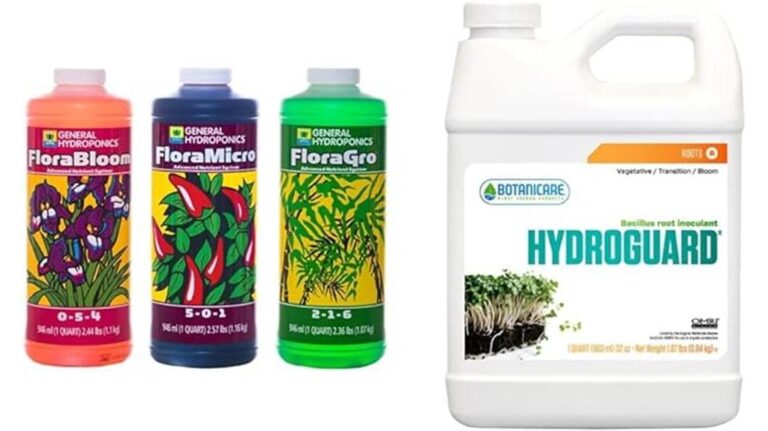

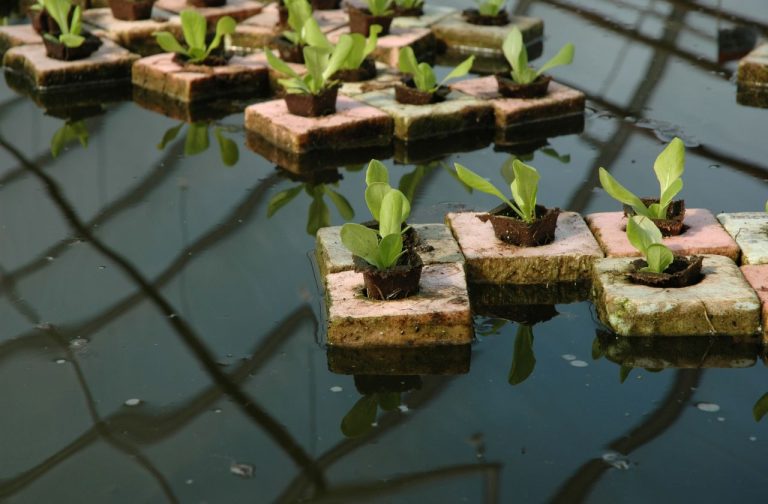
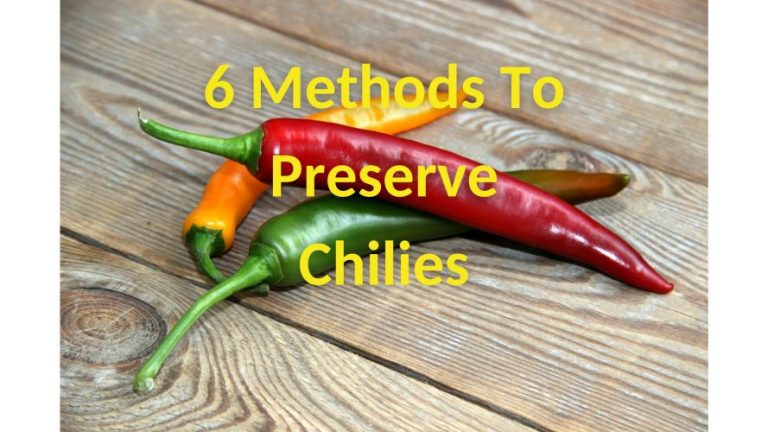
3 Comments